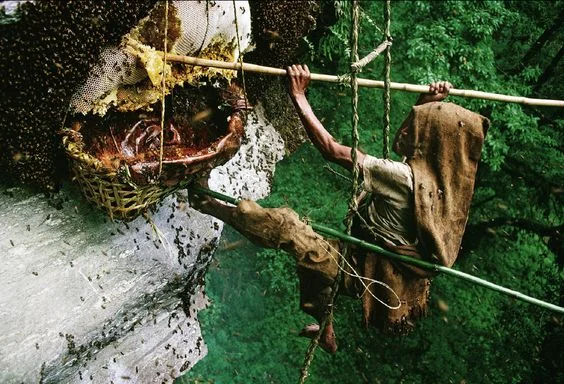With at least five different species, Nepal is rich in honeybee diversity. Honey hunters of Nepal risk their life and limbs to collect honey of wild honey bees from their nests located high up on craggy cliffs. For the aboriginal tribes involved in honey hunting, it is a vocation that is ancient in origin. Communities of different regions of the country apply different techniques, and practice their own kind of cultural-religious rituals before honey hunting, in which, usually, a dozen or so men are involved. A sacrifice, along with prayers, is offered to the gods before embarking on their hunt.
They carry age-old equipment devised from local materials, mostly bamboo and fiber of bamboo. These include long bamboo ladders (prang); lengthy bamboo stick, one end of which has a sickle attached (tango); a notched bamboo stick (saaton); basket made of bamboo (tokari); basket lining (chhyakhal); wooden knife (dabilo); filter (chcora); wax pot of wood (donga); and various types of ropes for different functions made of bamboo fiber (koili cho, koho cho, uab, pechowhibe, and tuju).
The first step is to light a fire of wood and foliage at the cliff base having the nests of wild bees, which compels the bees out of their combs and they fly upwards. The brood and honey sections are now revealed. A long rope ladder is then thrown down from the cliff top, and it is tied securely to trees on the top and at the bottom. One of the hunters fastens himself to this ladder and descends inch by inch, his safety and coordination ensured by his colleagues, who keep a sharp eye out. One of them, the primary coordinator, perches himself on an overhanging tree, and sends signals, as needed, to the others.
Using another rope, a large basket is lowered to the site of the nest, which is balanced under the comb by the honey hunter using a long stick. The brood portion of the comb is separated next, and a hole is pierced in the brood comb area. Then, the bamboo stick with the sickle is used to cut the comb. He then guides the collecting basket to catch the cut-away honey chunks. In this task, those holding the rope at the lower end also help. Once it is full, the basket is lowered, and sent up empty again. Anything from two to three hours may be needed to harvest one site. All this has been documented in Eric Vialli’s documentary, The Honey Hunters of Nepal, which captures the drama of a honey hunt by west-central Nepal’s Gurung honey hunters.
Certain superstitions are attached to wild bee honey hunting in Nepal. According to one such belief, Tuesdays are good days to go honey hunting, while Wednesdays are not. Another belief is that one shouldn’t honey hunt on the 8th, 11th, 23rd, 26th, and 30th day of the moon cycle. Similarly, mornings and evenings are the best times for honey hunting. Some communities believe that the presence of women aggravates the behavior of wild bees, making them quite dangerous; so women are prohibited from even watching the activity of honey hunting. As far as the men are concerned, the group shouldn’t have someone with a wife who is over six months’ pregnant, or in her period. Another interesting aspect of honey hunting in Nepal is that, most of the honey is collected from the world’s largest honeybee, Apis laboriosa, of which as many as two million may be present in one giant honeycomb.

